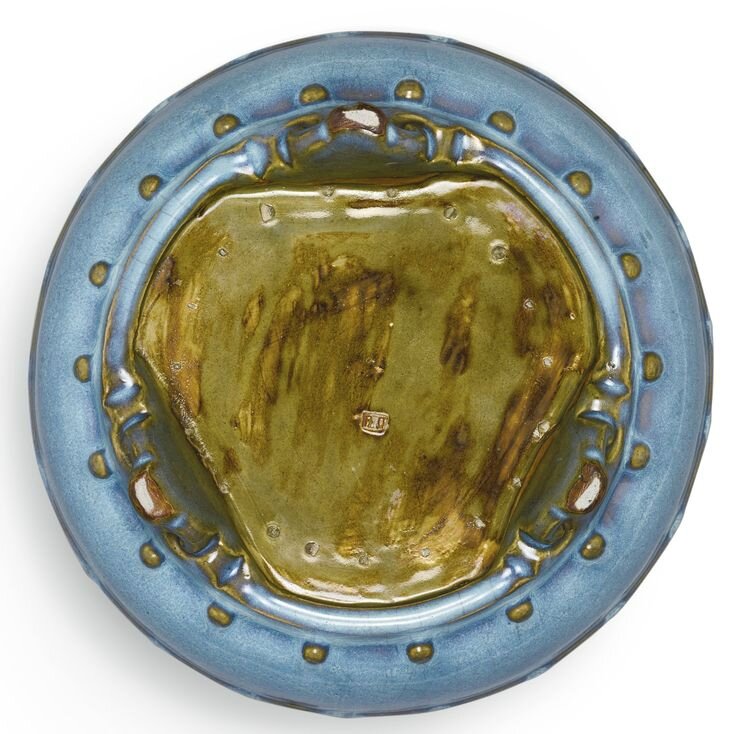A rare 'Jun' narcissus bowl, early Ming dynasty
Lot 81. A rare 'Jun' narcissus bowl, early Ming dynasty; 21.6cm., 8 3/4 in. Estimate 300,000 — 400,000 GBP. Lot sold 365,000 GBP. Photo Sotheby's
the rounded sides supported on three ruyi-shaped feet, encircled by a band of studs repeated between raised ribs on the slightly incurved rim, the fine purplish-blue glaze mottled overall in pale milky-blue and draining around the rim, on the raised studs and on the feet to a mushroom colour, the interior suffused with 'worm tracks', the flat base applied with a brown wash and with a ring of small spur marks, incised with the Chinese numeral si 'four' -
Provenance: Collection of Dr. W. Kilgenberg, Bonn.
The Reach Family Collection.
Christie's Hong Kong, 28th April 1997, lot 696.
Sotheby's Hong Kong, 2nd May 2000, lot 590.
Exhibition: Chinese Art from the Reach Family Collection, Eskenazi, London, 1989, cat. no. 24
Note: The present Jun narcissus bowl is representative of one of the most significant and interesting groups of ceramics ever made for the imperial court of China. A bowl of this form and similar sky-blue glaze, but engraved before firing with the numeral yi (one) and after firing with the name of the study of the Qianlong Emperor (r. 1736-1795), from the Qing Court collection and still in Beijing, is illustrated in Selection of Jun Ware. The Palace Museum's Collection and Archaeological Excavation, Beijing, 2013, cat. no. 115.
Jun ware, which derives its beauty from the striking and thick opaque glaze of varied bright blue coloration, was made in Junzhou Prefecture (today’s Yuzhou or Yuxian), Henan province, where ceramic production lasted from the Song (960-1279) to the Ming (1368-1644) dynasty. Among the products of these kilns, are a small number of flower pots including the present piece, which were inscribed on the underside before firing with a Chinese numeral ranging from one (the largest) to ten (the smallest), indicative of their size and matching stands; hence their name ‘Numbered Jun’ wares.
Numbered Jun wares were traditionally attributed to the Northern Song dynasty, although scholars nowadays are more inclined to ascribe them to the early Ming Dynasty. These vessels do not appear in any pre-Ming text or painting, and their form is similar to early Ming celadon-glazed flower vessels, such as one included in the exhibition Xuande Imperial Porcelain Excavated at Jingdezhen, Chang Foundation, Taipei, 1998, cat. no. 39. Scholars had traditionally relied on a mould for coins inscribed with the reign name of Emperor Huizong (1100-1126), Xuanhe, unearthed at the Jun kiln sites. The inscription on this mould however, is stylistically different to that found on genuine Xuanhe yuanbao coins. Furthermore, Thermoluminescence (TL) dating carried out by the Shanghai Museum has challenged the traditional Northern Song dating, suggesting that they were made remarkably later.
Jun vessels of this type are now held only in important museums and private collections; two lavender-glazed bowls similarly inscribed with the numeral si (four), in the National Palace Museum, Taipei, are included in the Illustrated Catalogue of Sung Dynasty Porcelain in the National Palace Museum: Jun Ware, Kuan ware, Chun Ware, Tokyo, 1973, pls. 64 and 66, together with two blue-glazed bowls of this type inscribed with the numeral yi ('one'), pls. 65 and 67, the latter with the so-called 'moon-white' glaze; and another from the collections of Harcourt Johnstone and Enid and Brodie Lodge was sold in our Hong Kong rooms, 30th April 1996, lot 306. See also a slightly larger blue-glazed bowl in the Idemitsu Museum of Arts, Tokyo, illustrated in Chinese Ceramics in the Idemitsu Collection, Tokyo, 1987, pl. 104; and another, from the T.Y. Chao collection, sold in our Hong Kong rooms, 19th May 1987, lot 210.
Sotheby's. Important Chinese Art, Londres, 11 nov. 2015, 11:00 AM

/https%3A%2F%2Fprofilepics.canalblog.com%2Fprofilepics%2F1%2F0%2F100183.jpg)
/https%3A%2F%2Fstorage.canalblog.com%2F03%2F02%2F119589%2F96711876_o.jpg)
/https%3A%2F%2Fstorage.canalblog.com%2F11%2F31%2F119589%2F94773502_o.jpg)
/https%3A%2F%2Fstorage.canalblog.com%2F20%2F83%2F119589%2F94772815_o.jpg)
/https%3A%2F%2Fstorage.canalblog.com%2F26%2F72%2F119589%2F75604929_o.jpg)
/https%3A%2F%2Fstorage.canalblog.com%2F59%2F60%2F119589%2F26458628_o.jpg)





/image%2F1371349%2F20240408%2Fob_9208fd_telechargement-13.jpg)
/http%3A%2F%2Fstorage.canalblog.com%2F07%2F09%2F119589%2F129760463_o.jpg)
/http%3A%2F%2Fstorage.canalblog.com%2F39%2F29%2F119589%2F129232075_o.jpg)
/http%3A%2F%2Fstorage.canalblog.com%2F77%2F10%2F119589%2F129137638_o.jpg)